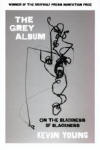The Grey Album
Kevin Young is smarter than I am, and a galactically better poet. Reading Young’s The Grey Album makes me feel dumb and confused, and part of that is due to his poetic leaps in tone from academic to vernacular. It’s also due to the fact that I’m ignorant. I am whiter than blank, and ignorant of more than half of Young’s references. But reading The Grey Album also makes me feel like reaching, like the exchange student who doesn’t yet speak or read the language, but her eyes and ears are burning to. With time, she’ll understand. With time, she’ll connect, become a part of the conversation. She just needs time. I just need time with Kevin Young’s essays.
Kevin Young is smarter than I am, and a galactically better poet. Reading Young’s The Grey Album makes me feel dumb and confused, and part of that is due to his poetic leaps in tone from academic to vernacular. It’s also due to the fact that I’m ignorant. I am whiter than blank, and ignorant of more than half of Young’s references. But reading The Grey Album also makes me feel like reaching, like the exchange student who doesn’t yet speak or read the language, but her eyes and ears are burning to. With time, she’ll understand. With time, she’ll connect, become a part of the conversation. She just needs time. I just need time with Kevin Young’s essays.
His collection’s title borrows from music producer Danger Mouse’s 2004 concept record, a mash-up of The Beatles’ The White Album and Jay-Z’s The Black Album. Young describes his book as “an attempt at a unifying theory, or evidence of my search for one. It is the story of what I read, heard, and saw at the crossroads of African American and American culture.”
The author plots American culture x as revolving around the y axis of black culture. But his book is anything but formulaic. Instead it bounds and riffs, producing its own mash-up of personal essay, cultural critique, poetry, and blues shout. It attempts to lead the charge “to rescue aspects of black culture abandoned even by black folks, whether it is the blues or home-cookin’ or broader forms of not just survival, but triumph.” To rally that charge, he dissects elements of blackness, spanning from slave narratives to mix tapes, from bebop to hip-hop to poetry: “A poetry not of witness, or of victimhood, or of experience or innocence, but of the moment after: write like a saint, not the picture of a saint. Write like the bone in the box, the relic to be kissed.”
In addition, the author evokes a Basquiat painting of his own mind and its cultural influences. The best example occurs in “Broken Giraffe,” a chapter in which the author reflects on his artistic relation to and deep appreciation of Beat poet Bob Kaufman, whose line “could be thought of as the series of riffs, of repetition with variation, that mark a jazz line.” Named after Kaufman’s poem “Song of the Broken Giraffe,” this essay tells as much about Young’s influences as it does about the surrealist Beatnik, its tone striking a note hovering effectively between personal and cultural, reflexive and informative. Young, too, has heard the broken giraffe’s song.
Broken is a refrain throughout The Grey Album, as are escape, freedom, shadow, that which is “left out,” pseudonyms/renaming, and the counterfeit. Of the last, he writes:
. . . the written, textual “counter fit,” which inverts the white-based construction of authentication. Instead of relying on the authority (and resulting authenticity) of white “fact,” the black author counterfeits such authority by way of fiction. Since previously conceived notions of truth have often oppressed black people, the counterfeit is a literary tool that fictionalizes a black “troof.”
In the chapter “Broken Tongue,” Young digs, performing literary archaeology with such artists as Paul Laurence Dunbar, the first widely popular black poet. This essay also aims to set the record straight regarding African American vernacular versus African American dialect. Young describes the latter as a product of the white plantation tradition—think Uncle Remus—while the former is a form of code, intended to confuse as much as to communicate, to remain “untranslatable,” dividing black from white, new-school from old-school, in-touch from out-of-touch: “English broken here.”
Come to think of it, broken is the best way to read this book—broken into tracks. Put the playlist on shuffle. Listen and respond. Listen some more.





